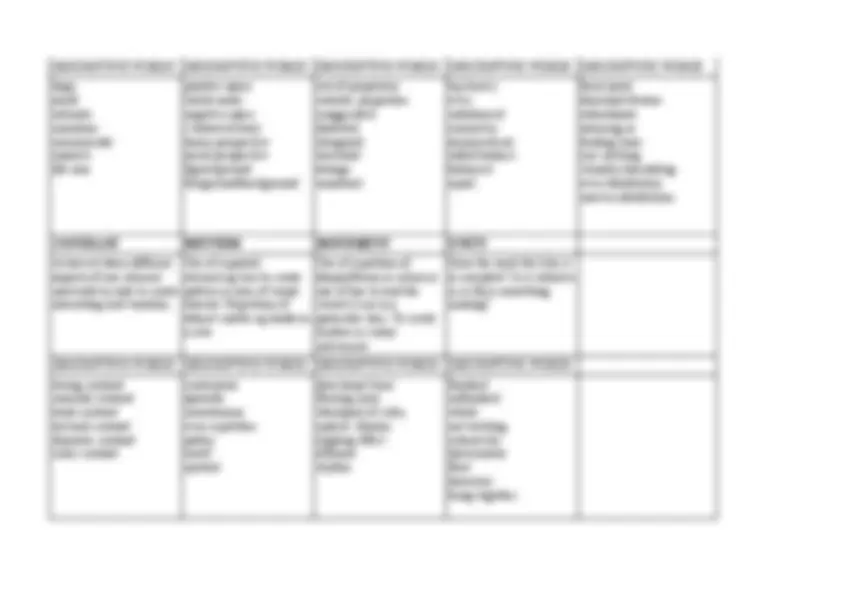



Study with the several resources on Docsity

Earn points by helping other students or get them with a premium plan


Prepare for your exams
Study with the several resources on Docsity

Earn points to download
Earn points by helping other students or get them with a premium plan
Community
Ask the community for help and clear up your study doubts
Discover the best universities in your country according to Docsity users
Free resources
Download our free guides on studying techniques, anxiety management strategies, and thesis advice from Docsity tutors
LINE , COLOR, TEXTURE, SHAPE, FORM, VALUE, SIZE are the principles of art composition
Typology: Lecture notes
1 / 3

This page cannot be seen from the preview
Don't miss anything!


An orderly arrangement of elements using the principles of design The principles of design help you to carefully plan and organize the elements of art so that you will hold interest and command attention. This is sometimes referred to as visual impact. In any work of art there is a thought process for the arrangement and use of the elements of design. The artist who works with the principles of good composition will create a more interesting piece of art it will be arranged to show a pleasing rhythm and movement. The center of interest will be strong and the viewers will not look away, instead, they will be drawn into the work. A good knowledge of composition is essential in producing good artwork. Some artists today like to bend or ignore these rules and therefore are experimenting with different forms of expression. We think that composition is very important. The following will assist you in understanding the basics of a good composition.
The Elements of Art are the building blocks of an artistic creation, a "visual language" or "visual alphabet" used by the artist. These are the primary aspects of visual perception. Every art work can be described by reference to these elements. For example, an art work will have strong line work or an absence of lines. An art work may have heavy use of tone or a complete lack of tone. LINE , COLOR, TEXTURE, SHAPE, FORM, VALUE, SIZE COLOR TONE TEXTURE LINE SHAPE/FORM The visual sensation dependent on the reflection or absorption of light. Means variation in the lightness or darkness of color used. The surface quality of materials either actual (tactile) or implied ( visual). Our eyes see boundaries of objects in terms of lines. Line delineates shape and form. Shape is the two dimensional space created by line or a boundary of color, tone or texture. form is the shape of a 3 dimensional object. DESCRIPTIVE WORDS DESCRIPTIVE WORDS DESCRIPTIVE WORDS DESCRIPTIVE WORDS DESCRIPTIVE WORDS vivid subtle/brilliant primary colors secondary tertiary complementary analogous warm cool color contrasting monochrome color scheme subtle muted flat tone light/dark chiaroscuro absence of tone tonal changes depth contrast shadow reflection rough/coarse smooth fine prickly embossed slippery crinkly fluffy silky woolly tactile spiky fine/thick curving/straight vertical/horizontal jagged/zigzag directional meandering broken dotted spiral wavy contour parallel geometric shapes square triangular circular organic/biomorphic curvaceous/curvy angular round/full figurative abstract form semi abstract cubist forms
palette muddy gloomy pigment hue value spectrum earthy mood tone shade tint neutralize blending graduated hard shiny soft silky rusty flaky lumpy touch surface hairy scaly grained dull sandy outline wiggly diagonal perpendicular horizontal flowing vertical edge hatched crosshatched blind contour stroke primitive forms muscular forms elongated cylinder cone cone cube 3D 2D irregular
The Principles of Design are a way of describing how an artist has combined the elements of Art within an art work. These elements are used to create the Principles of Design. Principles are the results of using the Elements. When you are working in a particular format (size and shape of the work surface) the principles are used to create interest, harmony and unity to the elements that you are using. You can use the Principles of design to check your composition to see if it has good structure.The principles of design are the recipe for a good work of art. The principles combine the elements to create an aesthetic placement of things that will produce a good design. SCALE, SPACE, UNITY, EMPHASIS, BALANCE, HARMONY, CONTRAST, MOVEMENT(RHYTHM) SCALE SPACE PROPORTION BALANCE EMPHASIS The overall size of the work, relative to other artworks of a similar type. In a 3D work this is the area occupied by the work, height width and depth. In a 2D work we refer to the illusion of space or depth. The relation between the scale of the shapes and forms within an art work. Is there a feeling of evenness in the distribution of color , texture, shape and form etc? What catches the viewer's eye most in the art work.